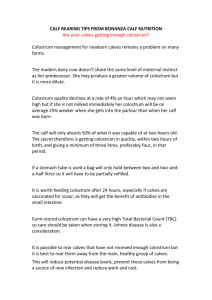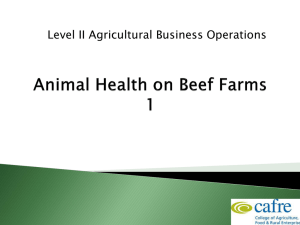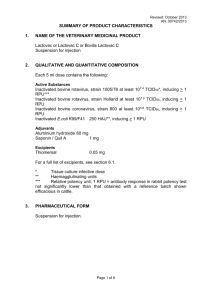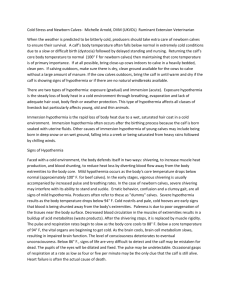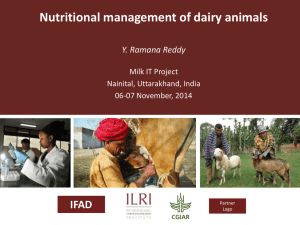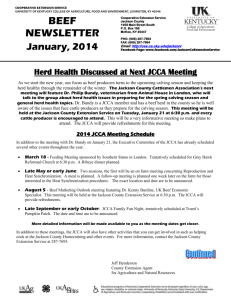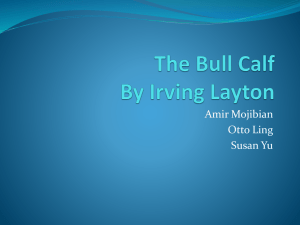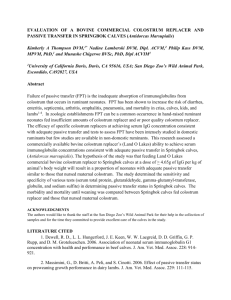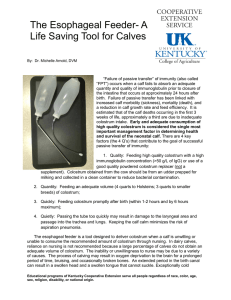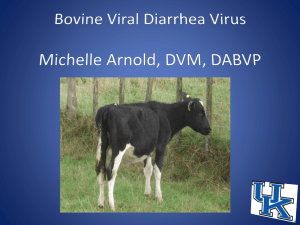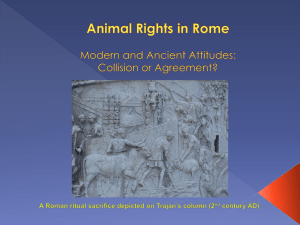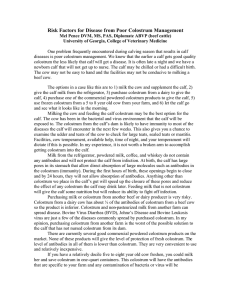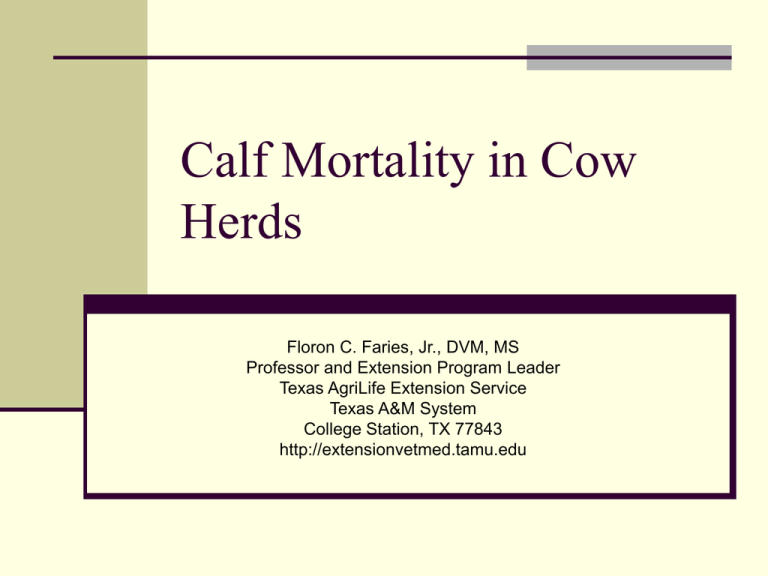
Calf Mortality in Cow
Herds
Floron C. Faries, Jr., DVM, MS
Professor and Extension Program Leader
Texas AgriLife Extension Service
Texas A&M System
College Station, TX 77843
http://extensionvetmed.tamu.edu
Calf Scours
Causative Disease Agents
Bacteria
E. coli
C. perfringens B, C
C. perfringens D
Salmonella
Viruses
Rotavirus
Coronavirus
BVD
Calf Ages
<5 da
5-30 da
>30 da
>15 da
5-15 da
5-15 da
>30 da
Protozoa
Cryptosporidia
Coccidia
5-30 da
>15 da
Calf Ages
Disease Agents
<5 da
E. coli
5-15 da
Rotavirus
Coronavirus
C. perfringens B, C
Cryptosporidia
15-30 da
C. perfringens B, C
Cryptosporidia
Coccidia
Salmonella
>30 da
Coccidia
Salmonella
C. perfringens D
BVD
Disease Agent Sources
Carrier Cows, Heifers
Manure – Vulva, ground (teats, haircoat,
grass, hay)
Diseased Calves
Scours – Ground (haircoat, grass, hay)
Calf Pathology/Signs
Intestinal Mucosa Damage
Irritation, necrosis, toxins
Diarrhea, Dehydration
Malabsorption
Hypersecretion
Colon fermentation, fluid retention
Electrolyte Imbalance
Acidosis – bicarbonate loss
Body Weakness
Reduced Nursing
Possible Septicemia
Calf Septicemia
Causative Disease Agents
E. coli
Lepto
Calf Pneumonia
Causative Disease Agents
Bacteria
Pasteurella
H. somnus
Viruses
IBR
PI3
BRSV
BVD
Stress
Weather
Weaning
Disease Incidence Factors
Carrier Cows, Heifers, Calves - Disease agents
Contaminated Environment - Disease agents
Stressed Cows, Heifers - Suppressed immunity
Disease agent shedding
Reduced colostrum quantity
Reduced colostrum globulins (quality)
Thin Cows, Heifers – Low Energy Diet
Reduced colostrum quantity
Reduced colostrum globulins (quality)
Heifers Colostrum – Lower quantity, quality
Calves Late Colostrum Intake
No local, systemic immunity
>6 hrs, >24 hrs after birth
Calves, Low Colostrum Intake
Weak local, systemic immunity
< 10% body weight – First 24 hrs
Weak local immunity
<10% body weight – Second day
<10% body weight – Third day
Stressed Calves
Dystocia, cold stress
Colostrum intake – Low, late
Heat stress
Globulin absorption - Reduced
Disease Management Practices
Sanitary Measures
Maternity pasture
7 da pre-calving to 1 da post-calving
15 acres per 75 females
Rotate pastures anually
Nursery pasture
3 wks
20 acres per 75 pairs
Rotate pastures annually
Nursing pasture
3 wks post-calving to weaning
Prevent overcrowdedness
Treatment pasture/pen
Isolate diseased calves
1 wk minimum
Haying, Supplement Feeding Facilities
Rotate locations
Manure removal
Shelter Facilities
Manure removal
Prevent Stress in Pregnant Cows, Heifers
Provide shelter, wind breaks
Energy diet (grain) – last trimester
Assure calf nursing
Within 6 hours of birth
Identify Reasons for Late/Low Colostrum
Intake/Absorption
Abandoned calf
Calf can’t find teat
Big teats
Weak calf
Calf kicked off
Calf not mothered
Udder not distended
Caesarean cow/heifer
Bottle Feed Non-nursing Calf
Within 6 hrs of Birth
Next 18 – 24 hrs
Colostrum quantity – 5% body weight
Colostrum quantity – 5% body weight
Days 2 and 3
Colostrum quantity – 10% body weight
Disease Diagnostic Procedures
Laboratory Tests of Fresh Scour Specimen
Bacteria culture/antibiotic sensitivity
Virus isolation
Protozoa demonstration
Disease Vaccination Practices
Pre-calving Vaccination of Pregnant Cows,
Heifers
Procedures
Intramuscularly, subcutaneously
2 doses, 2-3 and 6-8 wks before calving
1 dose annually
Products
E. coli K-99 Bacterin
Rotavirus/Coronavirus Vaccine (Killed, Modified
live)
C. perfringens C,D (B) Bacterin (7-way Blackleg)
Lepto (5–way)
IBR/PI3/BRSV/BVD
Pasteurella
H. somnus
Vaccination of Calves at Calving
Procedures
Orally
1 dose at birth
Products
E. coli K-99 Monoclonal Antibody
Rotavirus/Coronavirus Vaccine (Modified live)
Disease Treatment Practices
Dehydrated Calves
Procedures
Orally, intravenously, intramuscularly
Products
Oral electrolytes – 1 to 2 qts. Every 6 to 8 hrs.
Intravenous electrolytes
Antibiotics – E. coli septicemia
Genetic Defects
Homozygous Recessive Genes
Double Recessive Genes
Passed by both Parents
Anal Atresia
Scrotal Hernia
Cryptorchidism
Cleft Palate
Over-shot Jaw
Mulefoot
Dwarfism
Five-legged
Supernumerary Teats
No Teats
No Tail
Twinning
Genetic Inheritable (1% Rate)
Free Martins
Lighter Birth Weights
Heavier Dual Weaning Weights
Retained Placentas
Dystocias
Perinatal Calf Mortality
Reduced Fertility
Increased Nutritional Requirements

